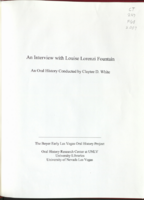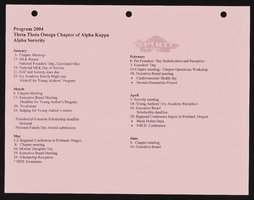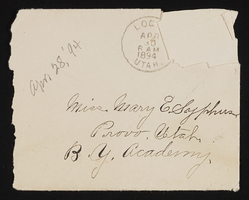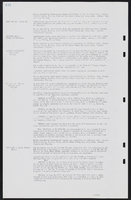Search the Special Collections and Archives Portal
Search Results

Transcript of interview with Louise Lorenzi Fountain by Claytee D. White, March 30, 2004
Date
Archival Collection
Description
Text
Earl A. Evans Jr. oral history interview
Identifier
Abstract
Oral history interview with Earl A. Evans conducted by Lance Malone on March 15, 1981 for the Ralph Roske Oral History Project on Early Las Vegas. In this interview Earl Evans discusses education, sports, employment, weather, and railroads in Las Vegas, Nevada. He also discusses transportation, recreation, community involvement, raising a family in Las Vegas, the development of Fremont and the Las Vegas Strip, and religious activities.
Archival Collection
Christie Young oral history interview
Identifier
Abstract
Oral history interview with Christie Young conducted by Dennis McBride on October 18, 1998 for the Las Vegas Gay, Lesbian, Bisexual and Transgender Archives Oral History Project. In the interview, Young talks about her early life in Reno, Nevada and her experiences with race and sexuality during this time. She then describes attending University of Nevada, Reno in 1974, getting pregnant, having an abortion, and the social implications of abortions. Young recalls moving to Las Vegas, Nevada in 1979 to study anthropology at University of Nevada, Las Vegas, learning about gay culture, and attending the Metropolitan Community Church. She then explains joining gay rights organizations as a straight woman, gay rights activism in the 1980s and 1990s, and stories of individuals within the Las Vegas gay community.
Archival Collection
Jinetta Daniels oral history interview
Identifier
Abstract
Oral history interview with Jinetta Daniels conducted by Rani Dunn on November 30, 2014 for the African Americans in Las Vegas: a Collaborative Oral History Project. In this interview, Daniels talks about her upbringing in Mississippi and traveling to Las Vegas, Nevada by bus in 1962. She continues discussing her work as a maid at the Dunes Hotel, her membership in the Victory Baptist Church, and comments on various church and community leaders in the Westside. She also mentions her concerns about the closure of F Street in 2008 and her hopes for the revitalization of the Westside community.
Archival Collection

Alpha Kappa Alpha Sorority, Theta Theta Omega Chapter calendar
Date
Archival Collection
Description
From the Alpha Kappa Alpha Sorority, Incorporated, Theta Theta Omega Chapter Records (MS-01014) -- Chapter records file.
Text

Letter and envelope from John M. Bunker, Logan, Utah, to Mary Etta Syphus, Provo, Utah
Date
Archival Collection
Description
From the Syphus-Bunker Papers (MS-00169). The folder contains an original handwritten letter, a typed transcription of the same letter, the original envelope with the stamp removed, and a copy of the original letter.
Text

Transcript of interview with Christopher Maestas by Claytee White, September 14, 2008
Date
Archival Collection
Description
Christopher “Chris” Maestas (1965-2009) was an engaged educator and leader within the Chicano, Latinx, and Henderson communities. As he traced back his Latinx heritage, he explored his father’s hometown in Llaves, New Mexico, where he and his family were discriminated for their non-white demeanor; and his mother’s paternal Spanish roots; his grandfather came to work in Henderson, Nevada at the Basic Magnesium Industrial (BMI) plants during World War II. The Chicano and Spanish cultures played a significant part in defining his role within the community. For Chris, Chicanos were “people that lived in the southwestern United States particularly southern Colorado, New Mexico and northern Arizona that were originally Mexican citizens before the treaty (Treaty of Guadalupe Hidalgo) was signed and then after the treaty was signed they became Americans.” In this interview, he dives into the difference between Chicano and Spanish cuisine and gives his own tips on how to make Spanish chile relleno. Chris discussed what life was like in Henderson living in Henderson Camp when his grandfather emigrated from Spain in 1943. He described the evolution of the Henderson community in the 50s through his parents’ experiences living in the Hispanic communities of Victory Village and Carver Park. During his childhood in the early 70s, Chris recalled living in Henderson when it was known as Basic and living in a small town-site house. One of his most special recollections was from the summer of 1980, when his family purchased their first set of air-conditioning units. As a passionate teacher and 1984 alumnus from Basic High School, he advocated student engagement as Student Council Advisor. Chris was also an active member of the St. Peter the Apostle, Catholic Church, Knights of the Columbus group and LUPE (Latinos United for Perfect Equality) Club. The LUPE club promoted equality for the Hispanic community and family values. Chris described their Saturday picnics at BMI Park and the annual Henderson Industrial Days festival.
Text



